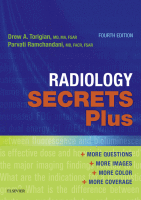Physical Address
304 North Cardinal St.
Dorchester Center, MA 02124

1 What is the drainage pathway for the maxillary, frontal, and anterior ethmoid air cells? The ostiomeatal complex is the common drainage pathway for the paranasal sinuses. It refers to the uncinate process, a small bone, and the spaces around…

1 The hyoid bone divides the neck into what two distinct regions? The hyoid bone divides the neck into the suprahyoid neck (extending from the skull base to the hyoid bone) and the infrahyoid neck (extending from the hyoid bone…

1 Identify parts of the spine labeled in Figure 42-1 . For the answer, see the figure legend. 2 What imaging modalities are most often used in the evaluation of spine pathology? Radiography, computed tomography (CT), magnetic resonance imaging (MRI),…

1 How is multiple sclerosis (MS) diagnosed? MS is the most common cause of acquired demyelinating disorders. The disease has a characteristic relapsing-remitting course and usually manifests between the third and fifth decades of life with a female predominance. On…

1 Identify the normal parts of the brain labeled 1 through 6 in Figure 40-1 . For the answer, see the figure legend. 2 What imaging modalities can be used to evaluate the brain? The two major noninvasive cross-sectional imaging…

Prostate Gland and Seminal Tract 1 What is the normal anatomy and imaging appearance of the prostate gland and seminal tract on ultrasonography (US), computed tomography (CT), and magnetic resonance imaging (MRI)? The prostate gland is an extraperitoneal fibromuscular gland…

1 What is the first-line imaging modality of the female pelvis and why? Common indications for pelvic imaging in a female patient include pelvic pain, pelvic masses, and abnormal bleeding. Ultrasonography (US) is the imaging modality of choice for evaluating…

1 What are the boundaries of the retroperitoneum? The retroperitoneum is bounded anteriorly by the posterior parietal peritoneum and posteriorly by the transversalis fascia and extends from the diaphragm to the pelvic brim. 2 What are the compartments of the…

1 What are common indications for computed tomography (CT) and magnetic resonance imaging (MRI) of the adrenal glands? The most common clinical indications include: Characterization of indeterminate adrenal lesions incidentally detected on prior cross-sectional imaging. The main goal in this…

1 What are the common indications for computed tomography (CT) and magnetic resonance imaging (MRI) of the kidneys? The most common clinical indications include: Characterization of indeterminate renal lesions detected on prior cross-sectional imaging. This is done most frequently to…